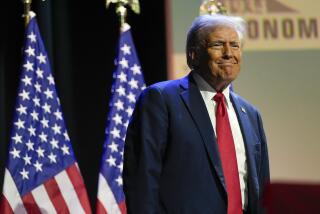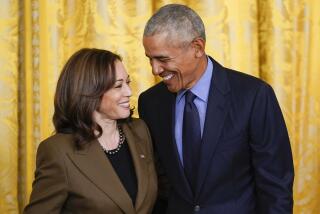What’s in a name? When you’re running for president, a lot
- Share via
Come, gather round and meet the 2020 Democratic candidates for president: There’s Amy, Cory, Beto, Bernie, Pete.
And Biden, Inslee, Warren.
Also Tim Ryan, Eric Swalwell and Kamala Harris For The People.
Set aside the split over Medicare for all, or which of the White House contestants has the most fully realized plan to fight climate change. One of the starker divisions in the sprawling Democratic field is how candidates present themselves — a friendly first name, a no-nonsense last name, or both first and last — in their logos, on their campaign websites and in other promotional materials.
Nomenclature won’t decide who wins the crowded primary. A logo may say little, if anything at all, about how an individual would govern as president. But those seeking political office and the consultants who advise them often go to great — sometimes excruciating — lengths deciding how best to brand a candidate for strategic purposes.
Who’s running for president and who’s not »
It’s no frivolous decision.
“A logo is the thing most people will see over and over again,” said Lisa Tucker, a strategist for four-term Bay Area Rep. Swalwell. (“He’s not Cher, or anything like that,” she said explaining why plain-old “Eric” wouldn’t do.)
“It will be on all your materials, generally in every shot of your candidate at every event,” Tucker continued. “It’s something that you give a lot of thought to because [visually] it’s the most important thing besides your candidate’s face.”
Professionals, of both the political and marketing stripe, agree what makes an effective campaign logo. The best, they said, communicate the basics — a name, of course, and some inkling of the office a candidate is seeking — but ideally project a good deal more.
“Successful political branding reinforces individuality or what defines a candidate, whatever that may be,” said Susan Merriam, a brand strategist and designer in New York, who co-founded the nonpartisan Center for American Politics and Design.
It’s something that you give a lot of thought to because [visually] it’s the most important thing besides your candidate’s face.
— Lisa Tucker, a strategist for Democratic presidential hopeful Eric Swalwell
Plain-old Bernie (as in the Vermont independent who battled Hillary Clinton in 2016 for the Democratic nomination) speaks to the unvarnished nature of the candidate with the slouching posture, mussy hair and prickly manner.
“It fits Sanders’ personality in terms of who is he,” said Mark Longabaugh, a media strategist for the senator’s 2016 campaign. “He’s not a person who’s particularly fussy about his appearance. He’s focused on the issues and substance. He’s not a pretentious politician. That’s one of his strengths.”
Kamala Harris For The People — not “Kamala,” not “Harris” — highlights the California senator’s background as a state and local prosecutor, a central part of her political identity, by quoting the words she used when rising to speak in court. “It was important to have that slogan … visible to people,” said Ian Sams, a campaign spokesman.
Separately, the typography and red-yellow-blue color scheme of Harris’ logo pay homage to the 1972 campaign of Shirley Chisholm, the first black woman to run as a major-party candidate for president, while at the same time reflecting the bid by Harris, who is biracial, to make history as the first woman president.
Trump and Biden, potential 2020 rivals, both head to Pennsylvania, a key battleground »
Other candidates employ their own optical cues.
New York Sen. Kirsten Gillibrand, whose gender is key to her candidacy, threads pink through her website and presidential logo. Former San Antonio Mayor Julián Castro features the acute accent (his name is pronounced WHO-leon), highlighting his status as the sole Latino candidate in the race. Washington Gov. Jay Inslee incorporates a stylized image of planet Earth, a reminder that climate change is the focus of his campaign.
(Biden — as in Joe Biden, the former vice president — offers little beyond his surname and the office he’s pursuing. Consider it the front-runner’s prerogative, or at least the recognition that comes from being in public life for half a century.)
Like any exercise in aesthetics, the response to a particular design is subject to individual tastes.
Eric Frankel, a veteran Hollywood media executive, praised Amy for America — the aw-shucksy motif of Minnesota Sen. Amy Klobuchar — “as a dignified, tasteful and catchily alliterative logo.”
But Steven Heller, who co-chairs the master of fine arts in design at New York’s School of Visual Arts, is no fan. Indeed, he disdains the entire “one-name trope,” with its chummy faux familiarity.
“Amy is not an Amy,” he said of the hair-triggered U.S. senator. “She’s got a temper. She’s not like the rest of us. That’s not how she’d want to be addressed.”
The Klobuchar campaign did not respond to a request for comment.
In a business that requires much in the way of negotiation and compromise, several political professionals said the design discussion is one they suffer grudgingly, as it often seems to spark some of the most passionate internal debate.
The approachability of a first name? The authority of just the last?
“It’s grueling,” said Fred Davis, a veteran Republican image-maker. “There are too many decision-makers. The candidate, the wife or husband of the candidate. Then the kitchen cabinet and then the family. The campaign team, general consultants, hangers-on. Everyone feels a need to weigh in.”
Craig Hughes, a Democratic consultant in Denver, echoed that lamentation.
“I hate logos,” said Hughes, who is advising Michael Bennet in his presidential bid. “I hate logo conference calls. I hate logo decisions.”
Still, Hughes allowed as how those visual encapsulations of a candidacy “have a look and feel that represents the campaign, and people see them regularly. So it leaves an impression.”
Thankfully, Hughes said, his candidate has been elected twice to the U.S. Senate running as Bennet for Colorado, so the decision was an easy one.
Bennet for America it is.
More to Read
Get the L.A. Times Politics newsletter
Deeply reported insights into legislation, politics and policy from Sacramento, Washington and beyond. In your inbox three times per week.
You may occasionally receive promotional content from the Los Angeles Times.











